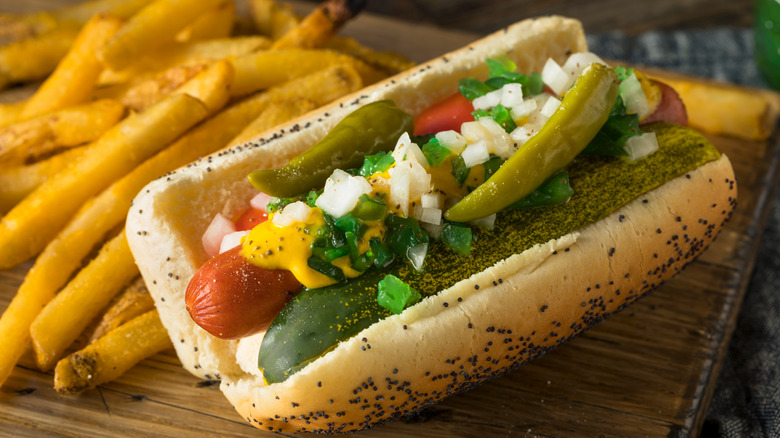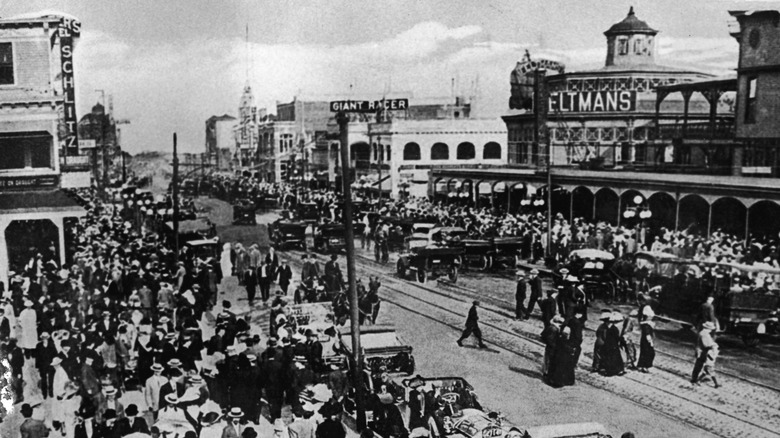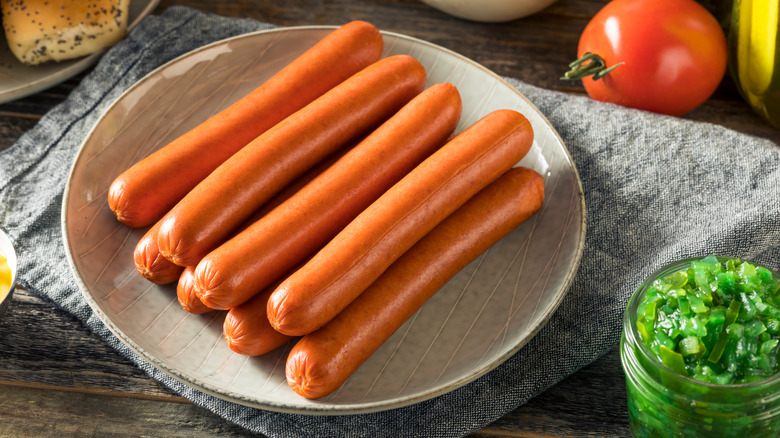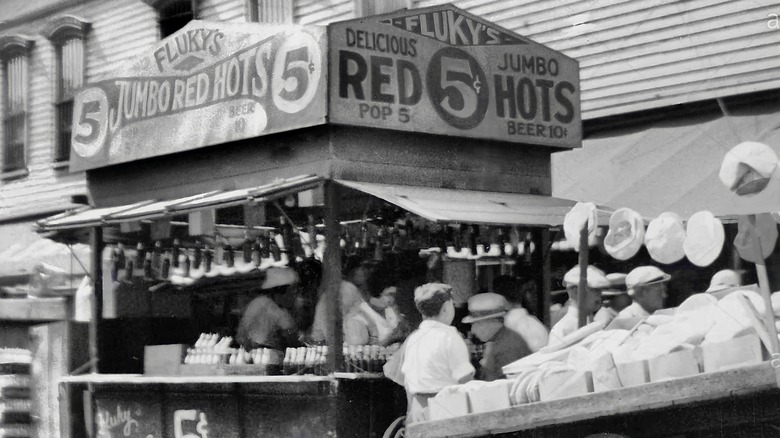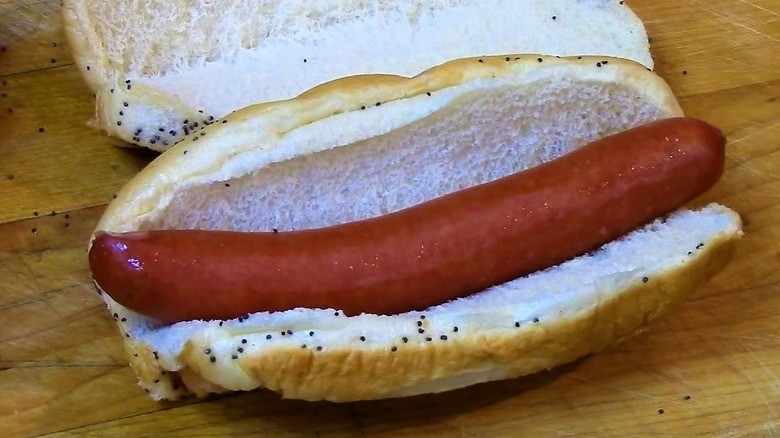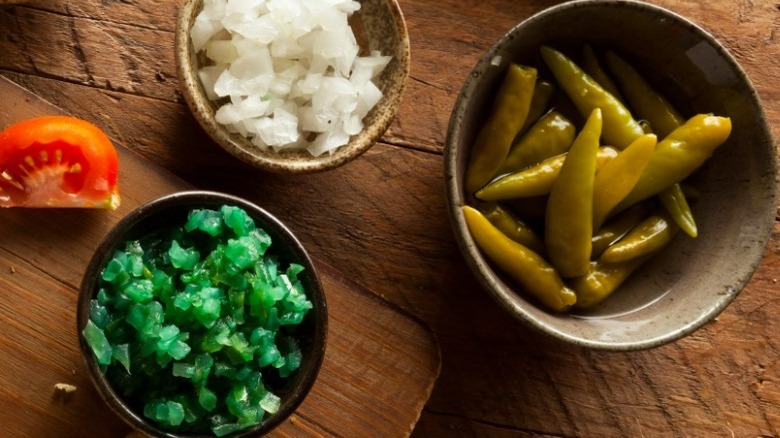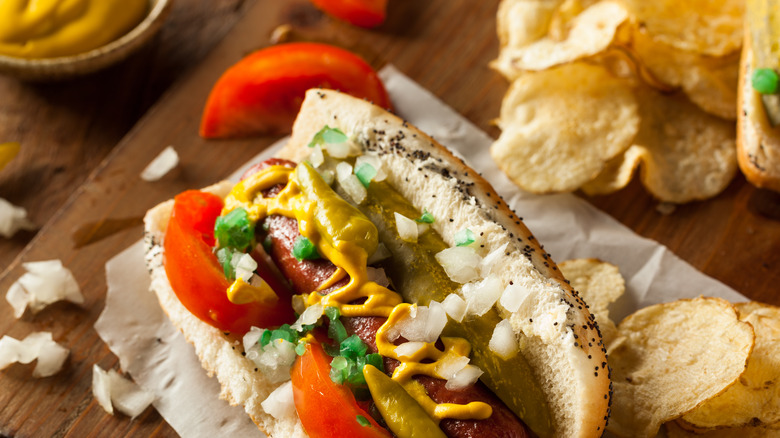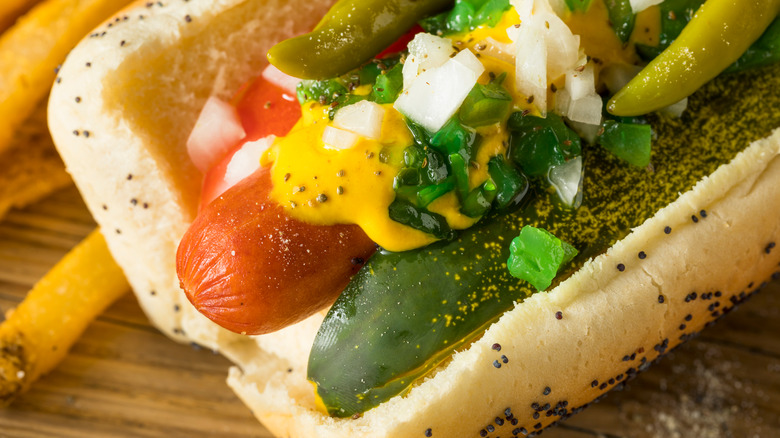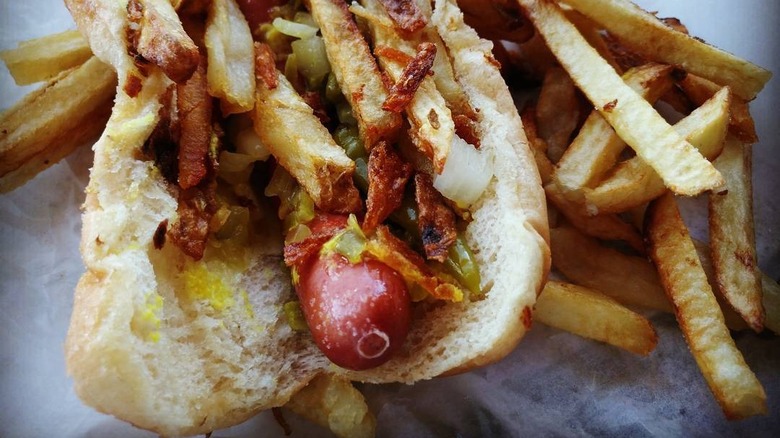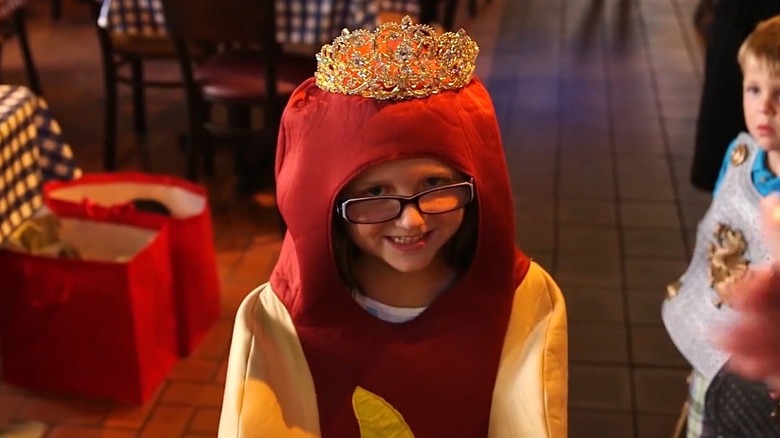The Untold Truth Of The Chicago-Style Hot Dog
The humble hot dog is an all-American classic that people across the country both love and love to hate on. Often scorned even as billions of them are scarfed down every year (according to the National Hot Dog and Sausage Council), hot dogs are perennial cheap street food and long-time stadium staple, as well as an undisputed star of summer BBQs. When elevated with idiosyncratic toppings in the specific style of a regional hot dog, wieners can also be delicious emblems of local pride. Even if you've never been to Illinois, chances are you've heard of the Chicago-style hot dog.
With seven toppings and a deep-seated grudge against a certain condiment, the Chicago dog is one of the most well-known and best-dressed varieties around. But it's not just about what goes on a Chicago-style hot dog (yellow mustard, raw onions, fresh tomato, pickle relish, sport peppers, a kosher dill, and celery salt) — or what doesn't (ketchup). The type of hot dog itself, the bun, and the cooking method are all equally important to a traditional Chicago dog. This iconic Windy City treat has a fascinating history that goes back to the Great Depression and beyond. In fact, the Chicago dog encapsulates much of the city's history in one reasonably neat, edible package.
We'll break it all down, from the dish's origins to its proper construction — and throw in some fun facts that underscore its unwavering popularity — to satisfy your curiosity and pique your appetite.
German immigrants introduced the hot dog to Chicago (and America)
While the exact geographic origins of hot dogs as we know them may never be pinned down, most sources, including What's Cooking America, agree that they descend from the sausages of Germany. Whether our hot dogs can be traced directly back to Frankfurt's eponymous frankfurters or Vienna's wieners remains in debate, as does the matter of precisely who first peddled hot dogs in America.
Many claim it was Charles Feltman, a German baker who moved to Coney Island and started selling sausages in buns in 1867 — but other German immigrants in New York and elsewhere were certainly in the same game at that time.
According to Thrillist, Chicago's oldest hot dog brand, David Berg, was established back in 1860, and by the 1880s, the city's massive meat industry was dominated by German immigrants. They produced a lot of trimmings and hot dogs were the perfect way to use them up. Despite the existence of detractors from their earliest days (H.L. Mencken reminisced in his memoir about eating circa-1886 hot dogs that were "rubber[y]" and "indigestible"), the general public fell fast in love with this cheap, tasty, and easy-to-eat food.
By the time of the 1893 Chicago World's Fair, hot dogs were a hot item. Thousands of attendees enjoyed bun-cradled sausages at the famous Columbian Exposition. And unlike traditional frankfurters and wienerwursts made from pork, these hot dogs were made from beef.
Most Chicago dogs are all beef
While many types of hot dogs exist today, made from ingredients as diverse as poultry and plant-based mixtures, the earliest examples were made from pork. Due to kosher dietary laws forbidding the consumption of pork, German Jewish butchers made their own all-beef hot dogs, and German Jewish immigrants brought these to our shores. In Chicago, Samuel Ladany and Emil Reichel founded the Vienna Sausage Manufacturing Company and served their Vienna Beef hot dogs at the 1893 World's Fair.
All-beef hot dogs have a deeper, meatier taste that can take heavier spicing than more delicate pork and poultry dogs without being overwhelmed (that's before you even get to the toppings). Furthermore, Thrillist suggests that 19th-century public perception was not only that these beefy wieners tasted better, but that they were safer to eat. Chicago's meatpacking industry was notoriously unsanitary, but kosher butchering practices were thought to put a much greater emphasis on cleanliness.
Whereas most hot dogs today are made from various trimmings for the protein quotient, all-beef hot dogs must contain only muscle tissue from a cow ... so, basically, it's a genuine tube steak.
Vienna Beef became an institution (and they bought David Berg, Chicago's original hot dog company, in 1992). Today, slow-smoked, natural-casing Vienna beef hot dogs are still the gold standard for a Chicago-style dog. Nothing's stopping you from enjoying a vegan Chicago-style hot dog if you don't eat meat, but diehard fans would argue you'd be missing the point.
The Chicago-style hot dog took off during the Great Depression
While all-beef hot dogs are the meat of the matter, what really makes one Chicago-style is the combination of toppings with which it is dressed. Today, the standard Magnificent Seven or Chicago Seven includes yellow mustard, raw onions and tomato, neon green relish, spicy sport peppers, a dill pickle spear, and a sprinkle of celery salt.
Now-defunct Chicago eatery Fluky's is credited with kicking off this piled-on toppings tradition during the 1930s. That's when they began selling a 5-cent hot dog capped with mustard, pickle relish, onions, a dill pickle, hot peppers, fresh tomatoes, and lettuce (as described by Block Club Chicago). You'll notice that lineup is a little different from the current combo of toppings, but the basic idea was to bulk up the meat-in-a-bun meal so customers could truly satisfy their hunger on no more than a nickel or two in those lean times. The addition of fresh vegetables brought some genuine nutritional benefits to boot, and took almost no extra time to prep and pile on.
Fluky's dubbed this a "Depression Sandwich" — signaling its inherent value as a properly bulky bite and casting its vote early as to that eternal question of whether a hot dog is or is not a sandwich. Other vendors followed suit and started offering hot dogs topped with plenty of fresh and pickled veggies and condiments. Somewhere along the way, the standard seven toppings so prevalent today became the preferred formula.
The hot dog and bun are both steamed
The traditional method of cooking a Chicago-style hot dog, per the Hot Dog Chicago Style website, is to gently steam it so it emerges hot, firm, and juicy, with a satisfying snap from the natural casing (i.e. intestine). You can find Chicago-style dogs made with skinless franks, but they won't be quite the same. Boiling should be avoided whenever possible. However, grilling the hot dog is also acceptable, at which point it becomes known as a char dog — perhaps most infamously peddled at The Wiener's Circle.
While the meat and the toppings tend to get most of the attention, the traditional poppy seed bun is equally important to an authentically delicious Chicago-style dog. According to The Chicago Sun-Times, the historic purveyor of said buns is S. Rosen's bakery, now owned by Alpha Baking Co. and currently producing roughly 5 million hot dog buns every week. No wonder they supply over 95% of Chicago's hot dog carts.
As for why the buns are studded with poppy seeds, most sources surmise its aesthetic, including The Chicago Tribune, though they also mention the connections to the concoction's Jewish roots. At this point, it's simply a time-honored tradition to use the speckled, seedy buns.
Like the hot dog itself, the bun should be gently steamed to tender perfection, never toasted. You'll get all the crisp, crunchy textures you need from the toppings and tube steak itself, while the pillowy bun provides a soft cushion.
You should never put ketchup on a Chicago-style dog
An inviolable rule of Chicago hot dogs is that you never, ever put ketchup on them. Plain yellow mustard, however, is essential. Not Dijon, not something grainy, just sharp, smooth, yellow mustard.
Arguments against ketchup abound. Some believe it's too sweet and would upset the symphonic balance of other flavors. Others guess it may go back to baseball vendors — and likely street cart owners too — shunning the sugary crimson condiment for the way it attracted flies and yellow jackets (via Greatist). Former president and Chicagoan Barack Obama famously condemned ketchup for grown-up palates, calling it unacceptable on a hot dog for anyone "past the age of 8" (per Today). The anti-ketchup crowd can even point to a cinematic memorialization of their stance in the Dirty Harry movie "Sudden Impact," in which Clint Eastwood's character vehemently denounces the practice of putting it on a hot dog.
Whatever the reason people have for hating ketchup on a Chicago dog in particular, it is a deep and unshakeable tenet. Many Chicago hot dog establishments decline to provide ketchup. Those that do may make you apply it yourself, unwilling to be actively involved in such a travesty.
While there is no such organized and vocal backlash against the possibility of mayo making an appearance on a Chicago-style hot dog, we wouldn't suggest risking the ire of devotees by even joking about it. Mustard is the beginning and the end of this non-debate.
Neon green relish and sport peppers are iconic condiments
Behold a Chicago-style hot dog and you will also be seeing green, most notably in the form of vibrant emerald pickle relish. Taste-wise, this is generally the same sort of sweet pickle relish you might find in any other city, but on a Chicago dog, it is often glowing bright green.
Why? Dining Chicago posits that a pickle relish producer probably injected more color to cover up uneven shading in a batch and liked the eye-catching result. According to Forbes, Vienna Beef started dyeing relish in order to make it pop in promotional photographs, where ordinary relish looked dull and unappetizing. Whoever started the trend, it's become a matter of tradition and yet another hallmark that distinguishes the Chicago-style hot dog from so many others. Per Chicago food community LTH, it's actually blue food coloring that makes the relish look so green.
The other somewhat unusual crunchy green condiment that comes on a Chicago-style hot dog is a pair of sport peppers. These are small, hot, pickled peppers that are similar to pepperoncinis but significantly spicier (per Chili Pepper Madness). The most likely reason they became known as sport peppers is that they were offered on top of hot dogs sold at baseball stadiums (via Fiery Foods Central).
They offer a tangy, spicy kick and subtle crunch and can be hard to find outside of Chicago. In a pinch, you could substitute pickled jalapeno peppers, but sport peppers are truly in a league of their own.
Fresh onions and tomatoes are also added
Raw onions have been a go-to hot dog topping since the early days, and most often are the only raw vegetable you'll find on one. Not so with a Chicago dog.
Fluky's Depression Sandwich brought fresh lettuce and tomatoes to the hot dog party in the 1930s, but this wasn't just a wild notion to combine a salad and a sandwich. Like many other hot dog vendors, Fluky's was located on Maxwell Street, which was also home to several vegetable stalls — so it made sense to use the produce to help bulk up their offerings. Different vendors dressed their dogs as they saw fit, but today, the only fresh produce that features on most Chicago dogs is diced, raw, white onions and two half-moon slices of raw tomato.
There are, of course, exceptions. Chicago establishment Byron's still offers fresh lettuce, crisp cucumber, and crunchy green bell peppers. In a notable swerve away from the norm, beloved local drive-in Superdawg replaces raw red tomatoes with pickled green tomatoes, which offer a year-round reliable punch of flavor.
No matter what spin each business puts on their specific roster of toppings, most Chicago dogs that are served with the works will include more than your average amount of raw veggies, so they can still be fairly accurately described as having been dragged through the garden (just don't use that phrase when ordering them, Hot Dog Chicago Style advises).
A kosher dill pickle and celery salt finish things off
In addition to all the other toppings barely contained within the bun, a Chicago-style hot dog boasts a dill pickle spear, which might seem superfluous when there's already pickle relish, but is not. The dill pickle adds its own distinctly snappy, juicy crunch, as well as a jolt of acid and subtle, savory spice, in delightful contrast to the sweeter relish. Kosher dill pickles — a natural addition to a kosher all-beef hot dog — traditionally contain garlic, which may not be immediately detectable but imparts another layer of nuance. The spear shape, of course, nestles perfectly in the bun beside the dog itself.
To complete the construction of a Chicago-style hot dog, the builder adds a final flourish of celery salt. This faintly grassy, almost herbal mixture of table salt and ground celery seed is used in Old Bay Seasoning, Bloody Marys, and is rumored to be part of the secret KFC spice mixture. But why is it sprinkled straight on top of a Chicago dog?
Because it tastes good. Bruce Kraig, food historian and Professor Emeritus at Chicago's Roosevelt University, says that celery salt was a common table condiment in 19th century Chicago, often appearing alongside the standard salt and pepper shakers in restaurants across the Midwest (via South Florida Sun-Sentinel). Clearly, it was a known quantity that was appreciated for its unique flavor, and hasn't gone out of fashion in Chicago.
You can find twists on the traditional formula
Gross permutations may be found in many places — one Reddit poster shared a particularly egregious example of a so-called Chicago-style dog from Australia — but even some Chicago-based restaurants offer their own interpretation of the canonized Chicago-style hot dog. Previously mentioned char dogs, pickled tomato-topped Superdawgs, and veggie-laden Byron's dogs can all be counted in this broader category.
Also worth a mention is the modern-day "Depression Dog." As its alternative moniker, the "Minimalist," might suggest, in one sense it's a stripped-down Chicago-style dog, in which the all-beef hot dog is usually smaller than the standard jumbo frank (via Serious Eats). It comes topped with only some of the Chicago Seven, namely: mustard, relish, raw onions, and sport peppers. In a move that 1930s-era eaters would no doubt have adored, today's Depression Dog is also loaded up with hand-cut French fries right in the bun. Gene & Jude's is a well-known purveyor of this style.
The Maxwell Street Polish is a spiritual and ethnic cousin of the Chicago dog equally worth seeking out in the city. A hot dog-adjacent Polish sausage, typically either grilled or fried, is tucked in a bun and topped with grilled onions, sport peppers, and yellow mustard. As the name implies, this meaty morsel originated in the same Maxwell Street market district that once housed Fluky's.
You may have noticed that, Australia aside, even when other liberties with the form are taken, ketchup still does not ever get a pass.
Conan O'Brien once commissioned the world's longest Chicago dog
So popular are Chicago-style hot dogs that you can now shop online for all the supplies you need to make them at home — but the experience of doing it yourself will never be the same (or as affordable) as enjoying them in their place of origin.
Conan O'Brien discovered the joy of Chicago-style hot dogs while filming in the city in 2012, and became so instantly enamored that he was inspired to commission a giant version from Vienna Beef. This behemoth red hot measured a frankly amazing 40 feet long, with a poppy seed bun to match. It was topped with all the requisite ingredients, of course, in staggering amounts: three pounds of pickle spears, one pound of sport peppers, two pounds of relish, four pounds of fresh tomato slices, four pounds of raw onions, two pounds of mustard, zero pounds of ketchup, and a respectable 1/8th pound of celery salt (via YouTube). All in all, it weighed in at 37 pounds.
This whopping wiener was not officially recognized as the world's longest Chicago-style dog, and neither was the slightly larger one put together by Midwest grocery chain Mariano's in 2018. For those keeping score at home, however, their dog came in at 43 feet (per ABC 7 Chicago) and dethroned Conan's creation, even if it was to no great fanfare. They dished their dog out to lucky customers once it had been documented for the annals of history.
Two Chicago institutions have appointed hot dog royalty
Forget Abe Froman, the fictional Sausage King of Chicago. Much-lauded Illinois chain Portillo's once crowned a very real — if not legally recognized by the United States government — Hot Dog Queen of Chicago (via NBC Chicago). You may remember Ainsley Turner as a bright spot in local news segments and social media posts in 2016, when she captured hearts by dressing up as a hot dog for her dance school's Princess Day. She began trending under #hotdogprincess, so her ascension to queenly status was only natural.
Although her costume was not as elaborately adorned as a real Chicago-style dog, it did prominently feature yellow mustard and no ketchup. For her coronation, she was flown to Chicago, where the then-7-year-old sampled a chili cheese dog. Understandable, as a Chicago-style hot dog is quite a mouthful even for adults.
In 2021, WGN TV reported the anointing of another hot dog queen of Chicago after Stephanie Esposito won a contest sponsored by Vienna Beef. Participants were challenged to visit as many hot dog stands as possible in a span of five weeks — Esposito managed to stop at 367 of them. Technically, she earned the less regal title of Top Dog, as emblazoned on her trophy, but there's no quibbling with the fact that she's a dedicated hot dog fan ... or just an incredibly competitive individual.
